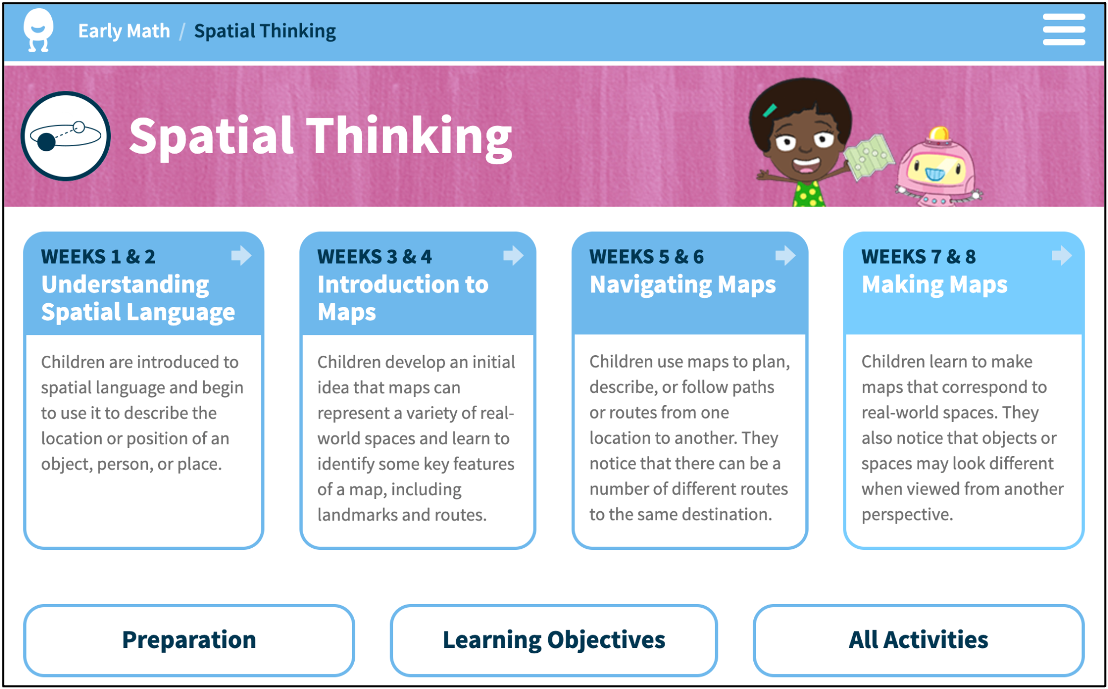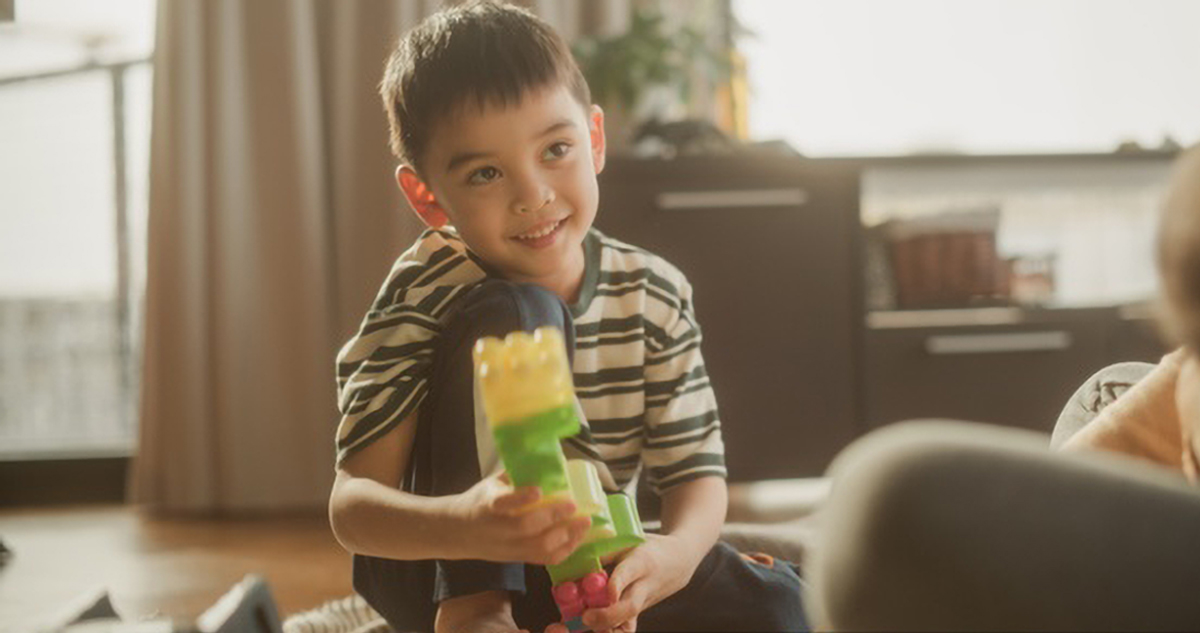Fostering Spatial Thinking in Young Children
by Ashley Lewis Presser
Spatial thinking—the ability to visualize, manipulate, and reason about objects in space—is essential for success in mathematics and other subjects such as science, engineering, and technology. Spatial thinking plays a role not only in learning about basic shapes, but it is also important in higher mathematics such as geometry and algebra. For instance, spatial thinking can help students to visualize word problems (e.g., using arrays to think about multiplication problems), picture equations and graphs, and to solve problems related to area, volume, and angles. In today’s world, where more time is spent indoors with increased passive screen time and limited opportunities for exploration and play, spatial skills are often underdeveloped in young children. However, research shows that young children can improve their spatial thinking by working with teachers (Casey et al., 2008) and parents (Borriello & Liben, 2018; Hall et al., 2023; Verdine et al., 2019).
Developing New Spatial Orientation Resources
Within the broader context of spatial thinking, spatial orientation involves using maps and models to represent and navigate through space while also incorporating spatial vocabulary (Clements & Sarama, 2014). As children develop this awareness, they also learn spatial vocabulary that helps them name these positions and express spatial relationships to others.
Education Development Center (EDC), in collaboration with GBH Education, developed free resources designed to foster young children’s spatial orientation skills and include activities for both school and home learning. The teacher guide is organized into four topics: (1) understanding spatial language, (2) introduction to maps, (3) navigating maps, and (4) making maps. These topics are interconnected, allowing teachers to reinforce earlier content as they progress. The program is designed to run over an 8-week period, but could be used over longer or shorter periods of time, depending on the classroom needs. Activities range from read-alouds, dance games, and discussions to augmented reality experiences using. Map Adventures and AR Adventures, both free and available through the Apple App Store. The family guide includes a variety of spatial learning opportunities, including reading books, engaging in digital activities, playing games with simple paper materials, and making use of mealtime and time spent “on the go.”
Throughout the development process, we involved preschool teachers, parents, and children in improving activities, and learned how to link home and school learning.

What did the Research Find?
The study that accompanied the development of the preschool spatial orientation curriculum and related home-based activities showed that teachers found the intervention feasible and engaging for children, and that it also showed improvements in children’s spatial knowledge. Additionally, caregivers reported increased interest in math among their children. The study emphasizes the need for effective resources to support spatial learning in preschool settings. It also suggests that AR technology has the potential to enhance these educational experiences but must be carefully scaffolded by an adult who can help set up the app and help the child interact within the augmented environment.
Tips to Foster Spatial Orientation Knowledge in the Classroom and at Home
To foster spatial orientation knowledge for young children in the classroom, consider the following tips.
- Incorporate Spatial Language. Use and encourage terms like “over,” “under,” “between,” and “next to” during everyday activities to help children understand spatial relationships. Incorporate spatial vocabulary into daily conversations. Phrases like “put the toy under the table” or “place the book next to the lamp” help children learn to describe and understand their environment.
- Create and Utilize Maps and Models. Engage children with simple maps of familiar environments (like their classroom, a playground, or a local park) or invite them to draw their own representations. Creating activities where children must find specific locations or objects helps them understand spatial relationships. Use models to represent real-world objects, helping them make connections between representations and reality.
- Include Manipulatives and Hands-On Activities. Introduce, make available, and integrate concrete objects such as blocks and counters during math activities. Implement hands-on games that involve navigation, such as obstacle courses or treasure hunts, where children must find objects using spatial cues. Engage in building activities using blocks, LEGO, or other construction toys that require children to think about how different pieces fit together in space.
- Share Stories with Spatial Themes. Read books that incorporate spatial vocabulary and concepts, encourage discussions about the locations and movements of characters within the stories. For example, read Piggies in the Pumpkin Patch, by Mary Peterson and Jennifer Rofé, which uses spatial vocabulary to describe animal characters moving around the farm; Mapping My Day, by Julie Dillemuth, in which the character makes and uses maps of places in her life (e.g., bedroom, obstacle course); and Lucy in the City, by Julie Dillemuth, which follows a raccoon as it navigates back home. Choose books that involve navigation or spatial themes, and discuss the characters’ movements and locations as you read, prompting questions about direction and distance.
- Encourage Outdoor Exploration. Provide opportunities for outdoor exploration where children can navigate and follow paths, identify landmarks, and describe different terrains and landmarks, to reinforce their spatial awareness through real-life experiences.
- Cook Together. Involve children in cooking activities that require measuring ingredients and following step-by-step instructions, which can enhance their understanding of spatial relationships and sequencing.
- Play Games. Play board games that involve movement on a game board or puzzles that require fitting pieces together, promoting critical thinking about space and position.
These strategies can create a rich environment for developing spatial orientation skills in young children.
By integrating these activities into everyday routines, teachers, parents, and caregivers can effectively support their children’s development of spatial orientation skills at school and at home.

by Aleksei Gorodenkov from Noun Project (CC BY-NC-ND 2.0)
Using Tablets to Foster Spatial Orientation Knowledge
To effectively use tablets to foster spatial orientation knowledge in children, consider the following options.
- Interactive Map Games. Engage children with games that involve map navigation, such as treasure hunts or adventure quests, where they must follow directions and locate items based on spatial clues.
- Building and Design Apps. Introduce construction and design apps that let children create structures or landscapes. This encourages them to think about spatial relationships and how different elements fit together in a space.
- Spatial Vocabulary Games. Use educational apps that focus on teaching spatial vocabulary through fun activities and challenges, helping children learn terms related to position, direction, and distance.
- Puzzle and Maze Apps. Encourage problem-solving skills with digital puzzles and maze games that require children to navigate paths and find solutions, enhancing their understanding of spatial reasoning.
- Storytelling with Interactive Elements. Choose e-books or storytelling apps that incorporate interactive features, allowing children to explore spatial concepts as they engage with the narrative and its settings.
- Virtual Field Trips. Take advantage of virtual tours of museums, parks, or historical sites, prompting discussions about spatial awareness and navigation within these environments.
- Collaborative Learning. Encourage group play with tablet-based games that require teamwork and communication, fostering social skills while exploring spatial concepts together.
By integrating these strategies into tablet use, parents and educators can create engaging learning experiences that enhance children’s spatial orientation skills.
Concluding Thoughts
Spatial thinking in early childhood development significantly affects children’s educational trajectories, particularly in mathematics and science, engineering, and technology. Research highlights the importance of integrating structured activities both in classrooms and at home to cultivate these essential skills. By providing practical resources and strategies, educators and parents can work collaboratively to create enriching environments that promote spatial awareness. The use of technology, such as augmented reality apps and interactive games, can be valuable tools in enhancing learning experiences. Ultimately, fostering spatial orientation knowledge not only supports academic success, but also equips children with vital cognitive skills necessary for navigating their world effectively.
References
Borriello, G. A., & Liben, L. S. (2018). Encouraging maternal guidance of preschoolers’ spatial thinking during block play. Child Development, 89(4), 1209-1222.
Casey, B. M., Andrews, N., Schindler, H., Kersh, J. E., Samper, A., & Copley, J. (2008). The development of spatial skills through interventions involving block building activities. Cognition and Instruction, 26(3), 269-309.
Clements, D. H., & Sarama, J. (2014). Learning and teaching early math: The learning trajectories approach (2nd ed.). Routledge.
Hall, L. V., Rengel, M., Bowley, H., Alvarez-Vargas, D., Abad, C., Overton, D., & Pruden, S. M. (2023). “You did a great job building that!” Links between parent–child prosocial talk and spatial language. Developmental Psychology, 59(9), 1676–1690.
Verdine, B. N., Zimmermann, L., Foster, L., Marzouk, M. A., Golinkoff, R. M., Hirsh-Pasek, K., & Newcombe, N. (2019). Effects of geometric toy design on parent-child interactions and spatial language. Early Childhood Research Quarterly, 46(1), 126-141.
The contents of this blog post were developed under a grant from the Department of Education. However, those contents do not necessarily represent the policy of the Department of Education, and you should not assume endorsement by the federal government.
This work is licensed under CC BY-NC-SA 4.0
Math for All is a professional development program that brings general and special education teachers together to enhance their skills in
planning and adapting mathematics lessons to ensure that all students achieve high-quality learning outcomes in mathematics.
